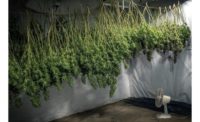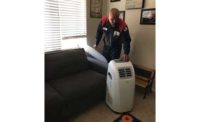Traditionally, portable cooling technology has been seen as a quick fix to immediate cooling needs. If a customer’s air conditioner went out in the busyness of summer, portable cooling could keep the customer comfortable until a technician could arrive at their home. Such needs and uses for portable cooling still exist, but over the past few years, portable cooling has increasingly developed as a solution for unique cooling needs. Manufacturers are saying this trend will continue.
Demand Driven by Need for Safety
Misty Wilburn, marketing manager for Portacool, said that the market’s renewed interested in employee safety and productivity is driving further demand for portable cooling solutions.
“From a safety standpoint, employers are looking for solutions that reduce heat stress and keep their employees cool,” she said. She explained that the industry is seeing a large shift surrounding employee safety. The California Division of Occupational Safety and Health (Cal/OSHA) has led this charge by putting regulations in place regarding indoor and outdoor working conditions and will likely be followed by other states.

PORTACOOL JETSTREAM: Portable air conditioning units can be used to keep a workspace cool and are often designed with heavy-duty wheels for easy transportation and setup.
“For operations that can’t use conventional a/c because of cost or efficiency, portable evaporative cooling — in setting up cool-down stations — can be key to meeting a lot of those regulations,” she said. In addition to this, she said that companies will be able to attract and keep the best employees if they provide a great work environment.
“Offering those portable cooling areas can keep up focus and morale, which overall increases the profitability of your workforce,” she said. Wilburn explained that contractors can offer this solution as one that will do the most for their customers while also being conscious of cost.
When choosing portable systems for their customers, Wilburn advised contractors to take note of the size of the space that needs to be cooled, the number of employees, electrical options, presence of a water supply, and whether it is an open or closed environment.
“By strategically positioning multiple large coolers, you can cool an entire area where you have lots of employees working,” she said. “If you want to spot cool an area and take the product wherever the work takes you, using one single smaller cooler might be the better option.”
All in all, she told contractors that it is important to choose a product that is as versatile as possible for the work environments the customers will find themselves in. Contractors should ensure the cooler is a plug-and-play model that can be set up with little technical skill needed. The degree of maintenance required is also important, as well as the expected lifespan of the equipment.
Contractors should widen their view of portable cooling applications, too.
“Evaporative cooling is effective in other applications such as farm agriculture, patios, gyms, outdoor venues, events, sports sidelines, offshore platforms, retail stores, rental car pickup facilities, airports, beer gardens, and fast food lines for outdoor employees,” she said. In agriculture, portable cooling has been used to cool individual stalls, especially for show animals.
Product manager Friedrich Air
Portable as Supplemental Cooling
“Is it dependable?” said Brittany Calderon, product manager for Friedrich Air. “Is it quiet? Is it energy-efficient? Those are the three main things that we hear our customers looking for. And of course, cost is always a factor.”

ATTIC MASTER: Strategically positioning a portable cooler can offer long-term area cooling, or supplemental cooling if the main a/c unit goes out.
Portable cooling can be used to keep areas of a home comfortable when the main air conditioning unit goes out.
“We recommend that contractors all keep a portable in the back of their truck to allow for supplemental cooling,” she said. “If somebody’s a/c goes out and they need to order a part, it’s going to take a few days. They can leave one of those portables at that customer’s house and everybody’s happy.”
Calderon said that a dual-hose portable air conditioner offers a really good solution for customer’s needs; it’s designed to cool areas faster, more efficiently, and without a complicated installation process. She said that portable cooling is often used to supplement other cooling systems. For example, 2019 had a relatively mild summer in the Northeast, and Friedrich saw interest grow in portable cooling — equipment that people could stow away in a closet when not in use.
Unique Applications for Portable Cooling
Mike Renier, vice president of sales for KwiKool, said that customers are realizing that portable cooling can be used for specific, unique applications, and contractors should keep that in mind.
“As the market has evolved, customers have gotten more demanding and not less,” he said. “And what that boils down to is that they’re looking for tailor-made solutions to application problems.”
Some examples of this, he said, include server rooms, electrical equipment rooms, and other high-tech areas where heat-generating equipment needs to be kept cool. These rooms generally have permanent systems in place to cool the equipment; however, these mechanical systems run the risk of occasional failure when components break.
“Customers don’t want to have to spend a tremendous amount of money having redundant permanent systems in place,” Renier said. “As an alternative, they can look to portables to supply the duplicated air conditioning.”
To operate as intended, such portable equipment will need to have high-efficiency, sensible capacity that can match the heat load, which contractors should look for. A portable cooler with a 1-ton heat load, he explained, will not be able to cool a room with a 5-ton heat load.
Portable technology should always be used with the end goal in mind. For example, KwiKool has developed a portable cooler with a hospital-grade HEPA filter and UV light system. The technology, called Biocool, is designed for use in laboratories and hospitals.
In other applications, cooled air must be moved long distances before it can be exhausted. Portable coolers, when properly designed to pump air further distances, can be temporarily installed in attics. On hot summer days, when attic temperatures can exceed safe temperatures, a portable cooler can be used to keep the heat tolerable for any employees working in that space.
Renier reminded contractors that there is a big division between residential and commercial portable cooling products.
“If all you want is some cheap, temporary air conditioning for a bedroom, those personal air conditioners are great,” he said. “But if you want to bring the serious capacity for a high-profile application, don’t buy the cheap stuff. It won’t work. You’re getting what you pay for.”











